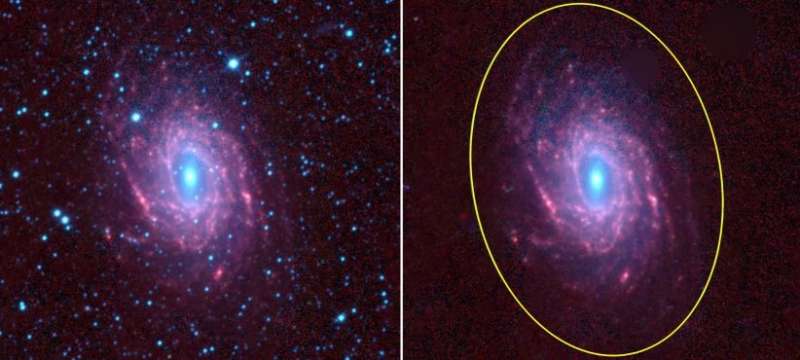February 19, 2018 report
Astronomers conduct a multi-frequency study of the Milky Way-like spiral galaxy NGC 6744

An international team of astronomers has conducted a multi-frequency study of NGC 6744, one of the most Milky Way-like spiral galaxies. The new research, published February 8 in a paper on arXiv.org, identifies radio and X-ray sources in NGC 6744 and estimates its star formation rate.
Discovered in 1823, NGC 6744 is an intermediate spiral galaxy located some about 30 million light years away in the constellation Pavo. It is thought to be one of the most Milky Way-like spiral galaxies in our immediate vicinity, and is perceived by astronomers as a useful analogue to our own galaxy when it comes to studying objects such as supernova remnants and H II regions—clouds of glowing gas and plasma in which star formation takes place.
When in 2005 a type Ic supernova was found in NGC 6744 at optical wavebands, astronomers started to observe this galaxy in detail across the electromagnetic spectrum with the aim of identifying more interesting objects there. One of the teams involved in the observations of NGC 6744 is an international group of astronomers led by Miranda Yew of the Western Sydney University, Australia, studying it as part of a wider research focused on nearby galaxies.
Now, Yew's team reports important results from their observations of NGC 6744, which include finding almost 400 radio and X-ray sources. The research is based on X-ray, radio and infrared data provided by NASA's e Chandra X-Ray Observatory, the Australia Telescope Compact Array (ATCA), the GaLactic and Extragalactic All-sky Murchison Widefield Array (GLEAM) and NASA's Wide-field Infrared Survey Explorer (WISE).
"We present a multi-frequency study of the intermediate spiral SAB(r)bc type galaxy NGC 6744, using available data from the Chandra X-Ray telescope, radio continuum data from the Australia Telescope Compact Array and Murchison Widefield Array, and Wide-field Infrared Survey Explorer infrared observations," the researchers wrote in the paper.
In an analysis of the available data, the astronomers identified 117 X-ray and 280 radio sources. One of these sources was classified as a supermassive black hole with a bolometric radio luminosity similar to the Milky Way's central black hole. Two of the newly found sources are likely supernova remnants, five were classified as supernova remnant candidates and 17 as H II regions. The remaining sources were categorized as background objects.
According to the study, the newly detected supernova remnants are particularly bright, but not as bright as Cassiopeia A, a supernova remnant in the constellation Cassiopeia. When it comes to the new H II regions, the researchers assume that 22-µm-dominated emission is likely to arise from the warm dust in the vicinity of these clouds.
Moreover, the team calculated that the star formation rate of NGC 6744 is between 2.8 and 4.7 solar masses per year—at least two times greater than that of the Milky Way. This value indicates that NGC 6744 is still actively forming stars.
More information: A Multi-Frequency Study of the Milky Way-like Spiral Galaxy NGC 6744, arXiv:1802.03075 [astro-ph.GA] arxiv.org/abs/1802.03075
Abstract
We present a multi-frequency study of the intermediate spiral SAB(r)bc type galaxy NGC 6744, using available data from the Chandra X-Ray telescope, radio continuum data from the Australia Telescope Compact Array and Murchison Widefield Array, and Wide-field Infrared Survey Explorer infrared observations. We identify 117 X-ray sources and 280 radio sources. Of these, we find nine sources in common between the X-ray and radio catalogues, one of which is a faint central black hole with a bolometric radio luminosity similar to the Milky Way's central black hole. We classify 5 objects as supernova remnant candidates, 2 objects as likely supernova remnants, 17 as HII regions, 1 source as an AGN; the remaining 255 radio sources are categorised as background objects and one X-ray source is classified as a foreground star. We find the star-formation rate (SFR) of NGC 6744 to be in the range 2.8 - 4.7 M⊙ yr−1 signifying the galaxy is still actively forming stars. The specific SFR of NGC 6744 is greater than that of late-type spirals such as the Milky Way, but considerably less that that of a typical starburst galaxy.
© 2018 Phys.org



















